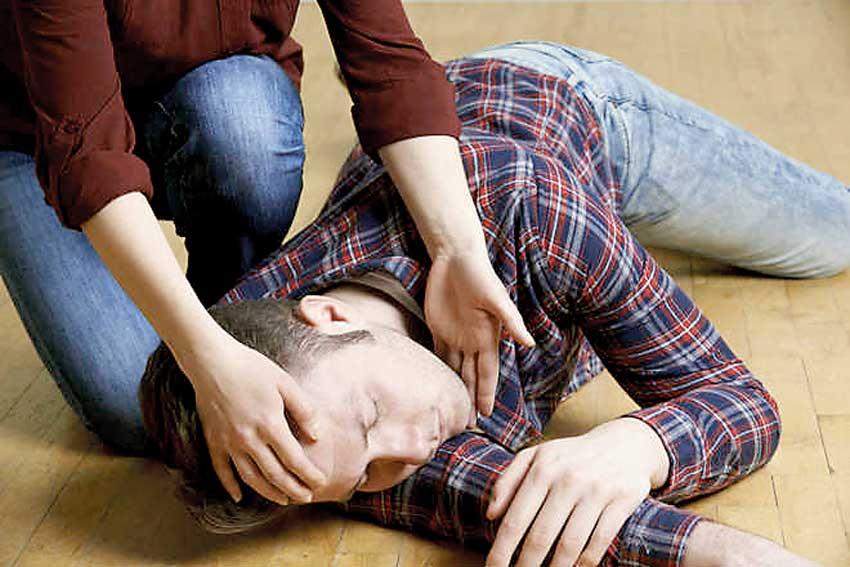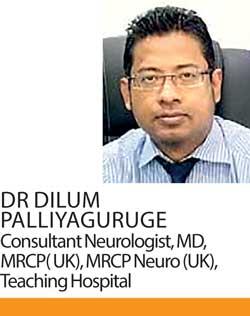22 Jan 2021 - {{hitsCtrl.values.hits}}

Durign a seizure, an epileptic patient should be rolled to their side to keep their airways clear
 “Being one of the commonest serious neurological conditions, affecting at least 50 million people worldwide with a current incidence of around 350,000 cases in Sri Lanka, epilepsy is defined as a chronic non-communicable disease characterised by recurrent unprovoked seizures, which can be brief episodes of involuntary movements, involving a part of the body (partial) or the entire body (generalised) and are sometimes accompanied by loss of consciousness and control of bowel or bladder function” says Dr Dilum Palliyaguruge, Consultant Neurologist, MD, MRCP( UK), MRCP Neuro (UK), Teaching Hospital, Kurunegala.
“Being one of the commonest serious neurological conditions, affecting at least 50 million people worldwide with a current incidence of around 350,000 cases in Sri Lanka, epilepsy is defined as a chronic non-communicable disease characterised by recurrent unprovoked seizures, which can be brief episodes of involuntary movements, involving a part of the body (partial) or the entire body (generalised) and are sometimes accompanied by loss of consciousness and control of bowel or bladder function” says Dr Dilum Palliyaguruge, Consultant Neurologist, MD, MRCP( UK), MRCP Neuro (UK), Teaching Hospital, Kurunegala.
Varying from brief lapses of attention or muscle jerks to severe and prolonged convulsions, epilepsy occurs due to an abnormal electrical activity of the brain cortex which can be a result of an insult to the brain in the form of an infection (encephalitis), head injury, stroke, tumour or genetic malformation. These fitting episodes are usually precipitated by sleep deprivation, hunger, stress, flashy bright light and alcohol. How Epilepsy presents in a person depends on the part of the brain affected, extension of it and the severity and there are several seizure types, categorised according to their presentation.
The most commonly come across scenario when it comes to Epileptic fit is an abnormal, jerky movement involving a complete or part of the body with eyes rolling up, frothing, tongue biting and bladder-bowel incontinence, often followed by post-ictal drowsiness, headache and transient memory loss. Other presentations could be rapid blinking and staring into space which usually lasts for few seconds, unprovoked falls, jerky and shaky movements of body parts etc.
A clinical diagnosis
“In fact, once a patient with fits presents to us, we take a comprehensive history from the patient as well from eye-witnesses, in order to get a clear idea about what happened before, during and after the incident” underscores Dr Palliyaguruge.
Additionally, bio-chemical investigations and imaging modalities including CT Head, EEG and MRI can be of use to identify the underlying cause (hyponatremia, infections, brain lesions) and will be helpful in deciding on the treatment as well. Anti-epileptic drugs and avoidance of precipitating factors play the hallmark of epilepsy treatment. In fact, around 2/3 of the patients respond to single or combined anti-epileptic drug therapy where remaining 1/3 may need surgery which has been available in Sri Lanka for the past 15 years.
“We have come across many epileptic patients who tend to stop drugs abruptly when they become seizure-free for sometime, but I need to emphasise on the fact that these therapeutic agents used for seizure prevention is more like an umbrella preventing you getting wet in rain and once you take it out, the seizures tend to recur. So the take home message is to be compliant on the drugs you have been prescribed with and not halting them without any medical advice” explains Dr Palliyaguruge.
Socio-economical and psychological impact
According to WHO, Epilepsy accounts for 0.5% of the global burden of disease, a time-based measure which combines the years of life lost due to premature mortality and time lived in less than full health.
“In fact, the real issue lies in the fact that most of these diagnosed epileptic patients, tend to suppress their true potential and skills behind the aforementioned, misinterpreted insecurities resulting in mental disturbances like anxiety, suicidal ideation and depression, thereby bringing down the quality of life.
Public awareness and loop-holes
WHO, having recognised epilepsy as a major public health concern, the International League Against Epilepsy (ILAE) and the International Bureau for Epilepsy (IBE) are leading ‘Global Campaign Against Epilepsy’ to bring the disease “Out of the Shadows” thus providing information and raising awareness to strengthen public and private efforts to reduce the impact of the disease.
21 Dec 2024 30 minute ago
21 Dec 2024 2 hours ago
21 Dec 2024 5 hours ago
21 Dec 2024 5 hours ago
21 Dec 2024 6 hours ago